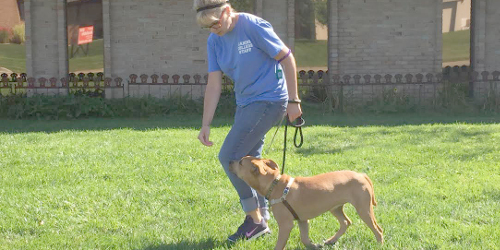BY CJ BENTLEY

Lead Trainer at Canine College in Farmington Hills, Debbi Boynton, with Monkey, a 4 1/2-month-old mix breed dog who is currently participating in the Puppy Development Program.
photo: S2_PET_CanineCollege_2538.jpg
If you share your life with a dog, you know the joy of receiving unconditional love. You know the comfort that comes from a furry head in your lap, and the fun of having a fetching buddy or a napping partner.
And…if you share your life with a dog, you probably also know a bit of frustration when your requests to "come inside" are ignored, or you're pulled down the street when a squirrel interrupts your peaceful stroll around the block.
Teaching dogs to behave is easy – and it's not. When it comes to dog training what's most important is your individual dog. There is no "one size fits all" in dog training. And that means just because a training technique worked for your neighbor or your coworker or your Aunt Martha – does not mean it will work for you.
And that's where Inside Out dog training comes in. To get your dog to behave on the outside – the behavior you see – you must first help him manage how he feels on the inside. For example: Let's say your dog walks along pretty well on a leash, until another
dog comes into view. Then your mild-mannered pet becomes a lunging, barking lunatic who is difficult to control, frightens people and embarrasses you.
To change that behavior you have a couple of choices. One choice is to focus only on the outside behavior – the barking and lunging. To do that, you will probably employ some form of punishment. That means when your dog reacts inappropriately, something bad happens to him. As a result, your dog may then choose to behave – on the outside – to avoid being punished.
Your other choice is to focus on the inside of your dog – determine WHY your dog is misbehaving and deal with his emotions. Oftentimes when dogs bark and lunge at other dogs they do so out of fear or insecurity (yep, even if it looks and sounds nasty). For those dogs, if we are able to help them feel more comfortable around other dogs we will have a better behaved, calmer dog when other dogs are present.
Both methods can "work." Its up to you, as your dog's advocate, to determine which method makes you the most comfortable. The "outside" technique can yield a quicker response. That is, many dogs learn to behave "better," more quickly because they fear being punished. The downside of that is your dog may still feel afraid or worried or frustrated. And in fact, his emotional discomfort may be made worse by adding the fear of being punished to the situation.
The "inside" technique takes longer, which is actually understandable. Your dog is a lot like you and it can take a bit of time to change his mind about how he feels. Imagine something you're afraid of or uncomfortable with. What would it take to make you no longer afraid? Some effort and time, right? But in the end you'd feel better, be more relaxed and behave with more confidence – all the extra time and effort would be worth it.
Helping dogs become more confident, calmer and focused pets is what training from the Inside Out is all about. It is a philosophy more and more pet parents are willing to invest in because they know they are helping their dogs to feel better and behave better – while at the same time strengthening their bond with their pet.
Sounds like a win-win-win.










